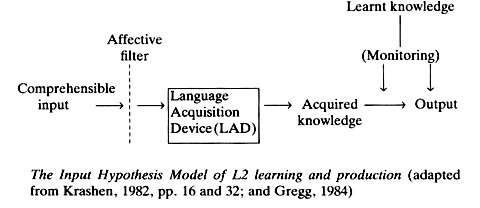Note 3 Input, Teaching Vocabulary
(Last updated: 9/5/2024)
1. The starting point: Input
Question: On Day 1 of a second/foreign language class, where do you start and how?
In theory, good input means
- Comprehensible
- Meaningful
- Optimal

Note: We will examine techniques in how to make input comprehensible throughout the rest of the semester.
2. Teaching vocabulary
Vocabulary is the basis of any language learning/acquistion.
2.1 What is vocabulary and what do we mean by knowing a word
Vocabulary is knowledge of words and their meanings. By knowing a word, we mean (c.f. Paul Nation 2000):
- Form
- Meaning
- Use
In addition, vocabulary knowledge can be
- Active (Productive)
- Passive (Receptive)
Morphology is about the rules of word formation.
2.2 Issues in vocabulary learning and instruction
We should be able to answer a few general questions, as list below.
- Vocabulary size: How many words should the students know?
- Vocabulary list: What are the words to be acquired?
- Vocabulary knowledge: What kind of vocabulary knowledge should students acquire?
- Vocabulary learning: What are the effective strategies for vocabulary learning?
- Vocabulary instruction: How to teach vocabulary?
2.3 What do we know about vocabulary learning
c.f. http://coerll.utexas.edu/methods/modules/vocabulary/01/teaching.php
Nation (2001) emphasizes that learning vocabulary is a cumulative process and that it must be deliberately taught, learned, and recycled. This is critical for several reasons:
- Learners need to encounter the words in a variety of rich contexts, often requiring up to sixteen encounters.
- Learners remember words when they have manipulated them in different ways, so variety is essential for vocabulary teaching.
- Learners forget words within the first twenty-four hours after class, so it is important to follow up a vocabulary lesson with homework that recycles the words.
2.4 Techniques of teaching vocabulary in classroom-based instruction
2.4.1 How
c.f. Nation (2005) http://www.asian-efl-journal.com/September_2005_EBook_editions.pdf
1. Meaning: Quickly give the meaning by
- (a) using an L1 translation,
- (b) using a known L2 synonym or a simple definition in the L2,
- (c) showing an object or picture,
- (d) giving quick demonstration,
- (e) drawing a simple picture or diagram,
- (f) breaking the word into parts and giving the meaning of the parts and the whole word (the word part strategy),
- (g) giving several example sentences with the word in context to show the meaning,
- (h) commenting on the underlying meaning of the word and other referents.
2. Form: Draw attention to the form of the word by
- (a) showing how the spelling of the word is like the spelling of known words,
- (b) giving the stress pattern of the word and its pronunciation,
- (c) showing the prefix, stem and suffix that make up the word,
- (d) getting the learners to repeat the pronunciation of the word,
- (e) writing the word on the board,
- (f) pointing out any spelling irregularity in the word.
3. Use: Draw attention to the use of the word by
- (a) quickly showing the grammatical pattern the word fits into (countable/uncountable, transitive/intransitive, etc),
- (b) giving a few similar collocates,
- (c) mentioning any restrictions on the use of the word (formal, colloquial, impolite, only used in the United States, only used with children, old fashioned, technical, infrequent),
- (d) giving a well known opposite, or a well known word describing the group or lexical set it fits into.
2.4.2 Principles
-
Keep the teaching simple and clear. Don't give complicated explanations.
-
Relate the present teaching to past knowledge by showing a pattern or analogies.
-
Use both oral and written presentation - write it on the blackboard as well as explaining.
-
Give most attention to words that are already partly known.
-
Tell the learners if it is a high frequency word that is worth noting for future attention.
-
Don't bring in other unknown or poorly known related words like near synonyms, opposites, or members of the same lexical set.
2.4.3 Five Ways of helping learners remember previously met words
-
Spend time on a word by dealing with two or three aspects of the word, such as its spelling, its pronunciation, its parts, related derived forms, its meaning, its collocations, its grammar, or restrictions on its use.
-
Get learners to do graded reading and listening to stories at the appropriate level.
-
Get learners to do speaking and writing activities based on written input that contains the words.
-
Get learners to do prepared activities that involve testing and teaching vocabulary, such as Same or different?, Find the difference, Word and picture matching.
-
Set aside a time each week for word by word revision of the vocabulary that occurred previously. List the words on the board and do the following activities.
-
go round the class getting each learner to say one of the words.
-
break the words into parts and label the meanings of the parts.
-
suggest collocations for the words.
-
recall the sentence where the word occurred and suggest another context.
- look at derived forms of the words.
-
2.5 Intentional vs. incidental vocabulary learning
Incidental learning is the process of learning something without the intention of doing so. It is also learning one thing while intending to learn another (Richards & Schmidt, 2002).
Refernece
Nation, P. (2001). Learning vocabulary in another language. Cambridge, UK: Cambridge University Press.
Richards, J., & Schmidt, R. (2002). Longman dictionary of language teaching and applied linguistics. Malaysia: Pearson Education.